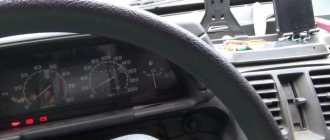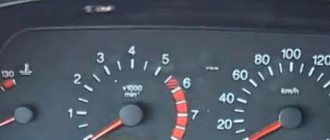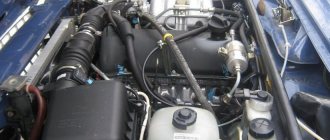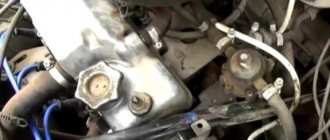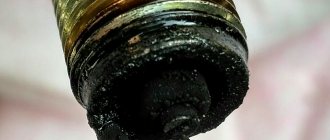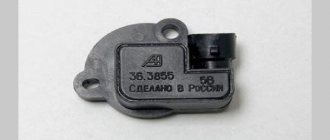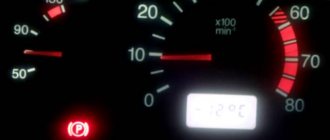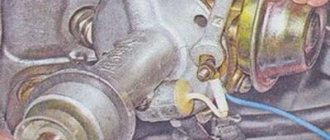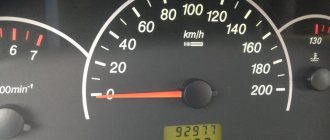Idle speed control
Statistics show that a breakdown of the idle speed controller, which is responsible for the appropriate engine speed, is the most common cause of engine shutdown.
Of course, such a breakdown is only suitable for an injection engine. How to be
: Check the correct operation of the idle speed control by cranking the crankshaft with the starter and simultaneously pressing the accelerator pedal. If the engine starts, but the speed increases, the IAC is broken. The problem is solved by replacing the spare part.
Note
: on VAZ MAC cars it changes in a couple of minutes.
Why does the VAZ-2107 injector stall the engine at idle?
A working engine in a VAZ-2107, the injector should work if the car is started, constantly, regardless of whether the vehicle is in motion or idling. Reasons why the engine stalls at idle:
- the idle speed controller is not functioning well;
- the throttle valve, channels related to the carburetor, and injector are heavily contaminated;
- the idle jet is dirty;
- it's time to clean the fuel pump and air filter;
- The mass air flow sensor and the sensor that reads the throttle position have refused to function;
- The crankcase ventilation mechanism of the VAZ-2107 engine is clogged.
To fix these problems, you need to remove each part and thoroughly clean it from dust and dirt.
The engine chokes when you press the gas
A fairly common situation when operating a car is when dips occur when you press the accelerator pedal, the engine stalls when overloaded with gas, the power unit does not pick up speed, suffocates, etc.
In this article, you will learn the reasons why the power unit responds to pressing the accelerator pedal with a delay or does not develop power.
Firstly, there can be many reasons for this type of malfunction. During initial diagnosis, it is important to observe characteristic symptoms that allow you to more accurately and quickly determine the malfunction. Next, we'll look at why the engine stalls when you press the accelerator pedal, as well as when the engine throttles when you press the throttle.
How does a carburetor work?
The operation of this mechanism is based on a process discovered by the Italian physicist Giovanni Venturi and named after him - air passing near the boundary of a liquid carries its particles along with it. In a carburetor, this effect is realized first by emulsion tubes, which produce primary mixing of fuel and air in certain proportions, and then in a diffuser, where the emulsion is mixed with the passing air flow.
A Venturi tube, namely a diffuser or an emulsion tube, works effectively only at a certain air speed. Therefore, the carburetor is equipped with additional systems that normalize the composition of the air-fuel mixture in various engine operating modes.
Carburetor design
A carburetor works effectively only when all its parts, as well as the entire engine, are in good working order and tuned. Any failure leads to a change in the composition of the air-fuel mixture, which changes the rate of its ignition and combustion, as well as the amount of exhaust gases released as a result of combustion. These gases push the piston and through the connecting rods rotate the crankshaft, which, in turn, converts the energy of their movement into rotational energy and torque.
A carburetor is a specific part of a car. If it breaks down, it can cause idle speed to float, require special starting techniques, and lead to jerky movement.
Throttle valve
Very often the engine stops because of the throttle. This happens due to contamination of its surface, which in turn occurs due to a malfunction of the air filter. You should also make sure that the position sensor (one of the variable resistors, which is installed on the damper axis) is in good condition.
How to be
: The problem can be quickly resolved by simply cleaning the inside of the throttle body. If the position sensor is broken, it will need to be replaced. The replacement procedure takes a couple of minutes. All spare parts are cheap.
Where to look for the reason
Often the cause of accelerator pedal dips is a drop in pressure in the fuel rail. For an injection car, the pressure in the ramp is considered normal at 2.8-3.2 Bar.
It is imperative to check the functionality of the sensors involved in the process of mixture formation and fuel supply to the cylinders, namely the throttle position sensor (TPS) and the crankshaft position sensor (CPS).
Failures in their operation will certainly lead to this problem. It would also be a good idea to check the performance of the injectors.
All these elements can be checked at home; it is enough to have a regular pressure gauge and multimeter on hand. With their help, the pressure in the ramp is first checked, and then the indicated sensors. Injectors are tested on special stands.
The injector starts and stalls
Fuel-injected cars may behave this way due to a faulty fuel pump. It's in the tank. It is very easy to check its functionality. If you turn the ignition key to the first position and listen, you will hear the pump working, pumping gasoline into the system.
Severe contamination of the fine fuel filter can also cause the car to stop after starting. The filter simply does not have time to pass the required amount of gasoline.
ECU errors very often lead to problems with starting the engine, failure to receive signals from certain sensors, or receiving them in a distorted form. It is better to diagnose such faults in specialized services.
Starter malfunction
The car starts using an electric starter. It is only possible that difficulties may arise.
They arise for the following reasons:
- The battery will be discharged;
- There will be a failure in the solenoid relay;
- The overrunning clutch will be inoperative.
If the car does not start, but the carburetor is working and the ignition system is configured to all standards, then most likely the reason is a breakdown of the starter. First you need to check the battery charge. If there is a deficiency, it should be recharged and re-tested for functionality. If after this procedure the problem remains, then the mechanism is removed for repair or replacement.
If you find out that the problem is in the starter, I recommend fixing it as shown in the video:
Fuel quality
Don't forget that the quality of the fuel you fill can directly affect the quality of the fuel you fill. Some cars and engines are not allowed to use certain types of fuel at all. Therefore, we monitor and remember what we pour into the tank.
How to be
: Empty the gas tank and replace the fuel filter if the vehicle has already started to stall due to fuel. After this, try to fill only the necessary fuel of the appropriate quality level.
Other reasons for incorrect starting of the VAZ 2107 engine
Another common problem that causes the engine of VAZ 2107 cars to start and stop is excess air getting into the carburetor. In this case, the fuel mixture cannot keep the engine running for a long time, and although the car starts, it stalls after a few seconds. It is necessary to determine the location of the air leak and eliminate the gap.
It happens that the injectors and nozzles of the dosing system become clogged. This also affects the reduction in engine speed, so that the VAZ 2107 stops after a few seconds. What to do in this case? It is necessary to unscrew the jets and pipes under the carburetor cover and clean them. Next, blow out the wells and nozzles with compressed air. If you have a Solex carburetor, you will also need to clean and bleed the fuel jets located at the bottom of the wells.
Signs of carburetor failure
If you notice some of these phenomena in the operation of the VAZ 2107, then you should carefully check the carburetor. You may find something broken in it.
- If the VAZ 2107 starts and immediately stalls, the carburetor may be the cause. All subsequent attempts to start the engine will be unsuccessful.
- In cases where the engine is difficult to start, the carburetor should also be checked. The car may stall after a short time of operation.
- If the engine stalls immediately after starting, this is also a sign of a carburetor problem. The engine will stall several times, and only after numerous attempts will you be able to start the VAZ 2022.
>>>> Ideas for life | NOVATE.RU
5. Fuel filter It doesn’t matter what the driver owns - a VAZ or a foreign car. All cars, without exception, crash “just as well” due to problems with the fuel filter. Most often, such a disaster happened to really old models that had been in service for more than a year. The engine stalls due to interruptions in the fuel supply, which, in turn, begins due to a dirty filter.
How to be
: It is necessary to remove the fuel pump and replace the filter. Check the bank for blockages. If there is one, clean the fuel tank to avoid a quick recurrence of the problem.
No fuel supply
When problems arise with the fuel supply on a VAZ 2107, regardless of the engine type, it simply will not be possible to start the power unit. You will need to understand the reasons and fix the problem.
On the injector
On an injection engine, the fuel pump located in the tank may break down. We check its performance and, based on the results obtained, perform certain actions: repair or carry out further diagnostics. Checking the fuel pump on the injection “seven” is quite simple: just turn on the ignition and listen to the operation of the mechanism. If there are no signs of the node functioning, it is worth understanding the lack of performance in more detail.
On an injection VAZ 2107, fuel may not enter the engine due to problems with the fuel pump located in the tank
On the carburetor
With a fuel pump on a carburetor engine, things are somewhat more complicated: the mechanism will have to be dismantled, disassembled and the condition of its structural elements diagnosed. Malfunction of the pump leads to the fact that fuel does not flow into the carburetor float chamber or does not flow in sufficient quantities. You can try to pump up gasoline manually, and also check the fuel pump:
- The hose is removed from the outlet fitting and lowered into a prepared container with fuel, which is necessary to supply gasoline to the carburetor.
- The prepared hose is put on the outlet fitting, and its other end is lowered into another empty container.
- The assistant starts the engine and keeps the speed within 2 thousand rpm. In addition, a stopwatch is started.
- After a minute, check the performance of the fuel pump by measuring the amount of gasoline pumped.
If the fuel volume is less than 1 liter, the fuel pump is considered faulty.
The car engine stalls while driving
List of reasons for stopping the carburetor engine of VAZ 2108, 2109, 21099, 2105, 2107 cars and their modifications when driving (in motion). This problem can arise due to malfunctions in various engine systems - fuel, ignition, etc. The gas tank has run out of fuel
In one case, the fuel level sensor readings may simply be incorrect (it has failed). Otherwise, even if the sensor indicates that there is little fuel left in the fuel tank, the fuel pick-up in this situation will pull water, dirt, deposits and deposits from the bottom of the gas tank. The engine will not run on such a mixture and will not even stop in motion, even at idle. It is recommended, in order to avoid such a problem, to periodically flush the gas tank and fuel lines as a preventive measure.
Cracked or clogged fuel line
Loose metal and rubber fuel lines can crack and wear out over time. This will cause the engine to lose fuel or run out of fuel and stall while driving. To prevent the occurrence of such malfunctions, periodic visual inspection of fuel lines along their entire length is recommended. It is also worth paying attention to the persistent smell of gasoline that occurs in this case.
Additionally, as described above, dirt and water from the tank can be sucked into the fuel lines. During the cold season, the presence of water in the fuel lines can lead to their freezing.
fuel lines, the breakage or damage of which is very dangerous, since fuel can enter the hot manifold and cause a fire, the condition of these pipelines must be constantly monitored
Disconnecting the central high voltage cable (armored cable)
A loose center high-voltage wire from the ignition coil to the distributor cap can become disconnected (jump) while the vehicle is moving, causing the spark to disappear and the engine to stall. In some cases, this situation is accompanied by a bang in the muffler. It is necessary to visually check the integrity of the central wire and the tightness of its tips in the sockets of the coil and cover.
Broken wire in the low voltage circuit
First of all, these are low-voltage wires of the ignition system (going to the coil, distributor, other devices of the ignition system, plugs in the fuse box). Secondly, this is the “ground” wire that connects the battery and the body (“ground”) of the car. Its breakdown or loose connection will lead to the engine stopping while driving, with the simultaneous disappearance of the light indication of the instruments on the panel, failure of the direction indicators, sound signals, etc. It is necessary to visually inspect the low voltage cables, find loose recommendations, and restore the connection of the “grounding” wires. To help the ignition system circuits 2108, 2109, 21099 and 2105, 2107.
Ignition timing violation
Sudden destruction of the elements of the ignition distributor (breakage or jamming of the springs of the centrifugal regulator), loosening of the elements and their displacement. Loosening the fastening of the distributor itself will lead to a shift in the ignition timing in one direction or another and will turn off the engine while driving. In such a situation, only a visual inspection of the distributor and troubleshooting followed by setting the ignition timing (2108, 2109, 21099 or 2105, 2107) will help.
automotive distributor 2108, 2109, 21099
Capacitor open to ground
Malfunction for VAZ 2105, 2107 cars with a contact ignition system. The capacitor on the distributor may suddenly fail and the engine will stop moving. This malfunction is accompanied by “shooting” at the muffler. The capacitor must be checked and replaced if faulty. As a temporary measure, it is recommended to disconnect the wire from the "K" terminal of the switch and continue. You can also use an audio capacitor. We connect its wire to terminal “P” of the ignition coil, and the housing to ground.
“Suction” of foreign air into the fuel system
In this case, the fuel mixture becomes very lean and the engine stalls. The cause of this may be a loose carburetor (air getting under its flange) or an intake manifold. The malfunction can be eliminated by tightening the carburetor and manifold mounting nuts or replacing the gaskets under them. For more information about “intake”, see “Intake of foreign air into the carburetor.”
points of intake of foreign air into the carburetor on VAZ 2108, 2109, 21099
Valve time lost
Perhaps a loose timing belt (on 2108, 2109, 21099) has lost a tooth or two.
Notes and additions
– In addition to the listed reasons for the sudden stop of a carburetor engine, there are many others. For example, dirt getting into the carburetor and clogging of the GDS jets.
Source
Ignition system malfunction
If life is complicated by the constant problem of poor ignition of the VAZ 2107 carburetor when cold, then it is possible to pay attention to the cause of unstable sparking. To eliminate suspicion, it is necessary to check the malfunction of the ignition system.
It is done in the following order:
- Inspection of all elements. Including ignition, wires, spark plugs, distributors.
- Make sure they are installed correctly.
- Monitoring the appearance of the contacts, the thickness of the gap between them and the ignition timing.
- Assessment of endurance of ignition system elements.
Why do carburetor cars start and stall?
If the car starts and stops immediately, the problem may be due to a lack of fuel in the float chamber. You can try manually pumping up the fuel pump. The work must be checked and replaced if necessary.
Before self-cleaning the fuel system in general and the carburetor in particular, you should remember that any unconscious manipulation can lead to a sharp increase in fuel consumption.
Another reason for engine stalling is a clogged strainer in the front carburetor. If the car starts and stops after a few seconds due to this filter, it needs to be cleaned and flushed. To do this, use a toothbrush and thinner (gasoline or acetone). After this, immediately clean the slot into which it is inserted together with the filter.
It happens that in VAZ cars, a few seconds after starting, the speed decreases due to a malfunction of the solenoid valve. The test is carried out as follows: the valve is unscrewed, power is supplied to the positive contact, the housing is closed to engine ground. If the valve is operating correctly, a distinct sound will be heard and the needle will enter the body.
You can simply connect the cable to the valve and push it into place. If you do not hear a click, the valve is faulty. We unscrew the valve and remove the jet from it. If it is bent, it needs to be replaced. Make sure the valve stopper needle moves freely and that the valve gasket is not torn and is tight against the body.
If there is valve clicking, the EPHC system needs to be diagnosed. The idle fuel jet may need to be cleaned. If the vehicle's engine speed decreases, the blockage can affect stability. To clean the nozzle, it is necessary to create a greater vacuum in the system channels.
To do this, start the car and increase the number of revolutions to 3000. Unscrew the injector holder (solenoid valve) several turns. This allows you to create the necessary vacuum in the channels. We repeat the procedure several times.
The main reasons for poor cold starting
There are several main reasons why starting a cold engine will be difficult or even impossible. To understand the cause of the malfunction, it is necessary to conduct a thorough diagnosis and localize the breakdown. First you need to check the battery, it is possible that it is completely discharged. Next, you need to check that the starter works and rotates the engine at the same speed. If you refuel with low-quality gasoline, this can also lead to the fact that your car’s engine will be difficult to start when cold.
The carburetor needle valve has become unusable
The carburetor overflows and moisture forms on the spark plugs. Replace the bad unit, as a small fuel leak can cause severe obstructions. You can see streaks of gasoline on the carburetor and smell its strong aroma. Remove the carburetor cover, determine whether the bracket is jamming into the float on its axis, whether the functioning of the float behind the walls of the float space is being disrupted, or whether the body is turning away from the needle valve. You can start the engine, so you need to turn it with the starter for a long time with a strong influence on the gas pedal. After a strong intake of air into the special combustion chambers, the candles will dry out and the fuel can be used for its intended purpose.
Try to monitor the integrity of the needle valve of the special chamber.
Obstacles have appeared in controlling the level of flammable liquid in a specific carburetor chamber.
Under the circumstances presented, the flammable liquid is saturated. As a result, the level of the fuel mixture in a special chamber increases. Try to adjust it.
Before you begin to find out the source of the problem that provokes the situation that a hot carburetor engine does not function, try to control the ignition, since the signs of its failure are similar to the signs of ignition failure.
VAZ 21043 classic, starts and immediately stalls
I sincerely recommend using this information to eliminate the cause of deficiencies in the carburetor for its normal operation.
Spark plug
Spark plugs, although infrequently, still fail. If a malfunction occurs, it is with one element, and not with all of them at once. If a spark is present on the spark plug wires, then to check the spark plugs themselves, they are unscrewed from the cylinder head of the “six” and an explosive cable is put on. The metal body of the spark plug touches the masses and turns the starter. If the spark plug element is working, then a spark will jump between the electrodes. However, it may also be absent from a working spark plug when the electrodes are filled with fuel.
In this case, the part needs to be dried, for example, on a gas stove or installed another one. In addition, it is recommended to check the gap between the electrodes with a feeler gauge. For a contact ignition system it should be 0.5–0.6 mm, for a contactless ignition system it should be 0.7–08 mm.
How to start a car without a key? : 3 comments
the basin is very easy to start if you are stealing, you need to rip off the door lock, and then rip off the panel under the steering wheel, then you need to rip off the chip from the wires so that they are free and connect the blue black and red and put the pink one on top))))) I have friends just before they were doing this, but they just put everyone in prison, you just need to think at the beginning and then take risks……….
I lost the key to my 1997 Toyota Kaldina. How to start?
Take a duplicate without a thread and stick it in a lot so that there is a thread
The starter spins for a long time on a carburetor engine
A tool for diagnosing problems in a carburetor engine are spark plugs. They need to be unscrewed and the condition of the electrode inspected, by the color of the deposit on which you can determine the presence of problems in the engine:
Dark red, brown soot indicates low quality of the fuel used. Most likely, such fuel contains metal impurities;
READ Chevrolet Niva Doesn't Start Check Light Isn't Lighting
Black or white carbon deposits indicate a rich or lean air-fuel mixture, respectively. It is necessary to check the fuel supply system, filters, carburetor ; The light brown color of carbon deposits on the electrode is an indication of normal engine operation.
If the starter spins for a long time when starting the engine, first check the battery, and only then all other engine components. In most cases, it is the lack of battery charge that causes difficulties when starting the engine.
VAZ 2106 (01-07) classic starts and stalls
Along with high efficiency and relative reliability, fuel-injected cars have one unpleasant drawback - the difficulty of repair. It happens that the injector suddenly stops starting, and it becomes difficult to do anything with it. It’s good if you have the opportunity to call a tow truck or show the car to a professional, but what should those motorists do who are left with the problem alone? Let's figure it out by examining in detail all the reasons why the injector starts poorly or refuses to start at all, as well as how to “treat” such a malfunction.
You've probably seen more than once while watching another action-packed movie how the main character gets behind the wheel of a car without keys, pulls out a bunch of wires from under it, connects something to something else, the car starts, and he drives away.
Because how to repeat the trick from the movie and how to start without an ignition key?
To do this, first you need to carefully get to the wires, which will require removing the protective cover located under the steering wheel.
After the protection is removed, you can see multi-colored wires running to the ignition system switch. Here it is worth separating the wires from the ignition switch in any convenient and accessible way.
After the wires are disconnected, it is worth determining which wire is where and what it is responsible for in the vehicle’s on-board system.
Let's start by defining the ground wire. Most often, this wire is painted green or black; on some cars, like in household appliances, it may be yellow with a thin green stripe along the entire length of the wire.
To check that the selected wire is indeed a ground wire, you can measure it with a multimeter by connecting one probe to the wire and the other to the car body. If the digital indicator shows zero, then we can conclude that “ground” has been found, right. The end of the wire should be insulated with electrical tape or a scraper, otherwise if there is an accidental short circuit with the supply wires, there is a high probability of damaging the vehicle’s on-board system.
The valve or EPH system is not functioning
The VAZ 2107 carburetor when it is hot, with the engine turned off, try to start the ignition and try to remove and fix the wire tip from the valve passage. You will hear a beep. If it does not occur, then fasten the parts of the wire plus the battery and the valve passage. The sound signal does not occur, then change the valve. If it occurs, check the EPH system. You also need to monitor the actual presence and performance of the dense rubber ring located on the valve.
Are Lada cars stalling? It starts and stalls. Doesn't hold speed. Repair of carburetor VAZ2107
2107 carburetor does not start well when hot on carburetors with an idle fuel jet holder - remove the holder and release the jet from it. We thoroughly clean the part and completely fix it in place.
Sources:
https://nralira.ru/ne-zavoditsa-vaz-2107/
VAZ 2107 does not idle: how to deal with the problem
VAZ 2107 is not the best model among cars of its class compared to foreign analogues. However, thanks to its low price and accessible service, the car has been popular throughout the post-Soviet space for many years. The car was produced from 1982 to 2014. That is, the oldest model is over 30 years old. During this period of operation, the owner will be able to cope with all types of malfunctions and investigate most of the causes of the malfunction.
After several years of operation, the VAZ 2107, like the almost identical model 2105, begins to show a new character with changes not for the better.
Malfunctions associated with the power unit and its body kit are of a different nature, but symptomatic:
- the engine stalls periodically;
- does not maintain stable dynamics;
- increased fuel consumption.
- difficult to start;
- unstable minimum;
- insufficient power;
All malfunctions arise for two reasons: violation of adjustments or wear of parts.
How to determine the cause of poor engine performance
Without understanding the principles of operation of the engine and its systems, it is impossible to determine why the power unit suddenly began to malfunction or stalled, however, even understanding the principles of its operation is useless without the ability to correctly interpret external manifestations and test results. Therefore, we have compiled a review of the most common malfunctions of carburetor engines that lead to cessation of operation, as well as their possible causes, and have made recommendations for correct diagnostics.
Remember, all this applies only to carburetor engines, and therefore does not apply to injection (including mono-injection) or diesel power units.
An injection engine is considered more durable than a carburetor engine. Experienced drivers note that with a new car you can forget about repairing the first one for two to three years.
In this section we will tell you how to look for the cause of a malfunction in case of certain problems that arise when operating a carburetor car. In the vast majority of cases, the cause of the defect is a malfunction or incorrect setting of the carburetor, however, the technical condition of other systems may affect it.
Doesn't start well and stalls when cold
If it is difficult to start a cold engine or the engine stalls when cold, but after warming up the idle speed stabilizes and there is no decrease in power or deterioration in throttle response, and fuel consumption has not increased, then here are the possible reasons:
- air leak;
- the jet of the XX system is clogged;
- the EPH valve jet is clogged;
- the channels of the XX carburetor system are clogged;
- The fuel level in the float chamber is incorrectly set.
Solving the problem of poor cold starting
More detailed information about these faults and how to eliminate them can be found here (The car stalls when cold).
Doesn't start well and stalls when hot
If a cold engine starts easily, but after warming up, as drivers say, “it turns hot,” it loses power or stalls, and also has difficulty starting, then here are the possible reasons:
- incorrect fuel level in the float chamber;
- air leak;
- incorrect adjustment of the mixture composition using quality and quantity screws;
- boiling of fuel in the carburetor;
- contact that disappears due to thermal expansion.
If the engine does not lose power, but after warming up it idles unstably, then, most likely, the carburetor's idle system is faulty, because warming up is carried out in the choke mode, and it involves opening the throttle valve slightly and air moving bypassing the idle system. You will find more detailed information on the reasons for this malfunction and repair methods here (Stalls when hot).
Incorrect adjustment of the XX quality and quantity screws is the most common cause of malfunction.
Unstable XX in all modes
If the car stalls at idle, but the engine has not lost power and throttle response, and fuel consumption remains at the same level, then the carburetor, or rather its technical condition, is almost always to blame. Moreover, almost always it is either dirt in the XX system or incorrect adjustment of this parameter. If, in addition to poor idling, the car loses power or some other defects appear, then a complete diagnosis of the power unit and fuel system is necessary. Read more about all this here (The car stalls at idle).
Engine idle speed
Stalls when you press the gas
If the car stalls when you press the gas, it doesn’t matter what type of carburetor it has, Solex, Ozone or some other, a simple check is not enough. Here is a list of possible reasons:
- incorrect OZ;
- the vacuum ignition corrector is faulty;
- air leak;
- faulty accelerator pump.
The moment when the engine suddenly stalls when you press the gas is extremely unpleasant and often takes the driver by surprise. It is unlikely that it will be possible to quickly understand the reason for this behavior of the vehicle.
You will find more detailed information here (Stalls while driving).
Stalls when releasing the gas pedal or braking the engine
If a car, for example, a Niva carburetor, stalls while driving when the gas pedal is released, then the reasons for this behavior are associated with a malfunction of the idle system, including the ESP, which interrupts the fuel supply when the engine braking. With a sudden release of gas, the carburetor gradually goes into idle mode, so any problem in the idle system leads to an insufficient supply of fuel to the power unit.
If the car is engine braking, that is, moving downhill in gear, but the gas is completely released, then the EPHH blocks the fuel supply, but immediately after pressing the accelerator, the economizer must resume the flow of gasoline. A stuck valve, as well as contamination of its nozzle, lead to the fact that after pressing on the gas, the engine does not start immediately, or does not start at all; if this happens on a winding mountain road, then there is a high probability of an emergency situation.
Valve stuck in engine
For an inexperienced driver, this situation often looks like this - you press the gas and the car with a carburetor stalls, there is no expected jerk or smooth acceleration (depending on many parameters), because of which the person behind the wheel gets lost and can make a mistake.
Unstable operation of the injection engine
Usually expressed in a spontaneous change in engine speed. Observed when driving and idling. The most common reason for the “walking” speed of the VAZ 2107/2105 fuel injection pump is the failure of the mass air flow sensor (mass air flow sensor).
This device controls the amount of air entering the engine. Based on this data, the ECU regulates the flow of the fuel mixture with the optimal ratio of fuel and air under various engine operating conditions. Consequently, in the absence of this balance, the engine speed begins to “float”.
It's easy enough to verify that the DMRV is faulty. Disconnect the device connector and the ECU will go into emergency mode. In this mode, fuel supply is controlled by the throttle position. If the car begins to behave more adequately, the MVR is faulty. You can drive this way, but the power will decrease slightly and fuel consumption will increase.
A faulty mass air flow sensor cannot be repaired other than getting dirty, so you can try cleaning it.
Cleaning algorithm for DMVR VAZ2107/2105:
- Remove the sensor along with the protective cover.
- Unscrew the two screws and remove the sensor from the base without touching the surfaces of the active element (current curved wire).
- Wash the body with any dishwashing detergent.
- Using a can of DMVR or alcohol-based carburetor cleaner (no acetone), gently wipe down the surfaces.
- Pour generously 3-4 times, the liquid should drain.
- Dry the device.
- Reassemble the block in reverse order.
If the problem persists, you will need to purchase a new device.
Why does the VAZ-2107 injector stall the engine at idle?
A working engine in a VAZ-2107, the injector should work if the car is started, constantly, regardless of whether the vehicle is in motion or idling. Reasons why the engine stalls at idle:
- the idle speed controller is not functioning well;
- the throttle valve, channels related to the carburetor, and injector are heavily contaminated;
- the idle jet is dirty;
- it's time to clean the fuel pump and air filter;
- The mass air flow sensor and the sensor that reads the throttle position have refused to function;
- The crankcase ventilation mechanism of the VAZ-2107 engine is clogged.
To fix these problems, you need to remove each part and thoroughly clean it from dust and dirt.
Unstable operation of the carburetor engine
The nature of instability of engine speed of a VAZ2107/2105 with carburetors is the same as that of an injection engine, in the uncontrolled supply of air or fuel into the combustion chamber.
But in this case, the carburetor is responsible for preparing the combustible mixture. This is a completely mechanical device responsible for the optimal ratio of fuel and oxygen for various operating modes of the power unit.
Although there are filters on the air intakes and fuel filters, they can typically operate ineffectively due to long service life beyond that specified in maintenance standards. As a result, small particles clog the carburetor jets.
Drivers with great experience do not spend much ceremony, throw the VAZ 2107/2105 carburetor into a bucket of gasoline for a day, then blow it out from all sides with compressed air, and the carburetor seems to work normally. This solution is questionable if the carburetor is very dirty.
Among the causes of engine malfunction caused by carburetor failure are:
- displacement of the position of the adjusting screws by shock or vibration;
- increase in nozzle diameter due to wear;
- failure of the float seal.
- clogging of jets;
- wear of the shock absorber axis, limiting its stroke;
To determine the malfunction of the VAZ 2107/2105 carburetor, and it will probably be complex, start by checking the float for leaks. To do this, remove it from the top cover of the carburetor (it must be disassembled). If there is gasoline in the float, throw it away; if there is air, make sure there are no bubbles in the bowl of water. Let's say he passed the exam, then he needs to check the gap.
Lift the carburetor cover to the vertical position. The distance between the float chamber and the carburetor wall should be 6.5 mm.
Install the carburetor cap and run the engine for 30 seconds. Remove the cover. The fuel level should be exactly in the center of the conical surface of the carburetor body. If this doesn't work, you should bend the corner of the float rod a little.
Over time, air and fuel jets become clogged or worn out. In the first case, they need to be cleaned and purged. In the second case, it is necessary to control the flow of the nozzles using a water tank installed above the nozzle, measured at 1 meter. They are connected by a pipe. A volumetric flask is installed at the bottom. Measurements are made in cm3/min. Depending on the marking of the nozzle, the volume of liquid collected per minute in the volumetric flask must correspond.
it is much easier to buy a set of jets and replace them after 7-10 years of carburetor operation.
Those who use gas systems should be aware that the carburetor is not used when driving on gas. Over time, oxide builds up inside dry injectors and clogs the fuel supply ports. A gasoline car may not start. It is recommended to use gasoline periodically.
Adjusting the fuel level in the float chamber (Solex carburetors)
In addition to all of the above, engine speed drops if the fuel level in the carburetor (float chamber) is incorrectly adjusted. As a result, there is either not enough gasoline in the fuel mixture or too much of it.
When adjusting the VAZ 2107 carburetor, it does not need to be disconnected from the engine. Follow these steps:
- remove the air filter housing by unscrewing all fasteners;
- remove the carburetor cover;
- check the position of the floats. To do this, separate and bring them together to achieve the correct location.
It is necessary to achieve such a position of the floats so that they move freely without clinging to the walls of the chamber in which they are located. It will not be superfluous to measure the distance from the protrusions on the floats to the paper gasket. The distance should be within 0.75–1.25 mm. Use a feeler gauge to measure.
What to do if it is far from normal? In this case, you need to adjust the height of each of the floats. As we have seen, there are many reasons why the engine stalls. To start the engine correctly, you need to check and eliminate all the above faults. Afterwards, if the problem is not resolved, you will have to contact specialists.
Causes of failure of the carburetor VAZ 2107
Here we will describe step by step all the possible reasons why the VAZ 2107 starts and crashes.
If the cause of carburetor failure is a lack of fuel in the float chamber, then there is a high probability that the fuel pump or fuel system is also faulty. Simply remove the hose from the fuel inlet. Next, make a couple of presses on the manual fuel supply lever. Gasoline should come out of the pipe hole. If the jet was weak or missing, a detailed check of the fuel pump and fuel system should be performed.
A clogged filter is also a common cause of carburetor failure. Eliminating this cause will be very simple. You will need to remove the filter and then clean it. To clean, use a toothbrush or something similar.
You can try cleaning the filter with acetone. A can of compressed air can also help. Blow out the entire filter. Clean the filter seat. Sometimes it may be necessary to completely replace this part, but it is better to try to simply clean it.
Broken solenoid valve or fuel jet of the idle system
First of all, you need to look at the location of the fuel nozzle and solenoid valve. Due to some damage, it may come off, which is why the breakdown occurs. Trust him. Also try removing the threads from the valve and putting them back on. You should hear a characteristic click. Indicates that the valve is operating. If you do not hear a click, connect the positive battery cable and the valve terminal. If you do not hear a click, the valve needs to be replaced. If there is a clicking sound, it is worth checking the EPHC system.
The functionality of the valve can be checked by removing the fuel nozzle from it. Examine it carefully. It should not be contaminated or damaged. Look at the O-ring and lock the needle. The nozzle must be thoroughly cleaned and blown with compressed air.
This is a very common problem that will be difficult to solve. For this reason, the car does not always stop. This can happen if the fuel mixture is very lean with excess air. This is why in the VAZ 2107 the carburetor starts and stalls. In this case, it is necessary to check the entire carburetor.
Particularly susceptible to:
- Valve ring;
- Vacuum cleaner hose;
- High quality threaded ring.
- Pipe to valve cover;
Sometimes it is easier to replace the entire carburetor.
Trigger diaphragm damaged
If the reason lies in the diaphragm of the trigger device, it will have to be completely disassembled and hung. Sometimes a complete starter replacement may be necessary, but not often. This will need to be adjusted. Be sure to replace the diaphragm with a new one.
Clogged fuel and air jets
The emulsion wells and dosing system piping may also become blocked.
You will need to disassemble the carburetor, remove the above parts and clean them. To clean, you need to use acetone, a brush and a can of compressed air. They must be cleaned of any visible dirt. It is worth noting that in Solex and ozone systems the components will be the same. Only their position is different.
For cleaning you need:
- Air nozzles;
- Emulsion tubes;
- Emulsion wells.
- Fuel jets;
All components must be clean, even if some of them are not very dirty. This will help avoid another breakup.
Clogged fuel and air jets of the idle system
Clogging of these sections of the carburetor can also cause the VAZ 2107 to start and immediately stall. In this case, you will have to disassemble them. This is quite simple to do; you just need to carefully unscrew the jets. Next, they need to be cleaned and blown with compressed air. Sometimes they may need to be replaced. You can try cleaning the jets without completely disassembling the carburetor. This will significantly reduce cleaning time.
The fuel level in the float chamber is broken
This is a very common reason why the carburetor gets stuck in a VAZ 2107. This is due to incorrect fuel level adjustment. The fact is that the fuel mixture is disturbed. It can be highly enriched or, on the contrary, depleted. In this case, you need to make changes. This may take a long time, but it will prevent carburetor failure.
Choke not adjusted
Because the throttle may not be fully open, the fuel may be richer. Most often this does not lead to serious problems, but sometimes the fuel becomes so rich that the engine is very difficult to start. Especially if he was warmed by a long journey. In this case, it is worth adjusting the air damper (intake). Sometimes a highly enriched mixture can even flood the candles.
If the air damper is working properly, it should cover the right section of the chamber. This occurs when the handle is fully extended. And if the handle is recessed, it should stand vertically. If this does not happen, the cause of carburetor failure lies precisely in incorrect adjustment of the air damper. The adaptation will not take much time.
Speed drops on VAZ-2107 (injector)
December 7, 2010, 20:24 #1
Good afternoon, tell me who can. When you switch to netralka from speed, the engine speed drops (the oil and battery lights come on briefly), then the speed immediately returns to normal. But this doesn't always happen. And today the revs dropped completely and the car stalled, the car stalled three times while driving from work. But oddly enough, it starts up well. Tell me who has encountered such a problem.
December 7, 2010, 20:30 #2
Idle speed sensor most likely but better for diagnostics
Belgorod region Belgorod
Renault Logan 1.4
December 7, 2010, 21:59 #3
Here is the idle speed sensor. My friend 2107 had the same problem, he replaced the hall sensor. progress and everything is ok. if I'm not mistaken 350 rubles. and half an hour of work in the garage. These are the prices for spare parts that make this classic a source of envy.
December 7, 2010, 10:39 pm #4
Why does it take so long to change on a front-wheel drive 10 minutes? and the price is almost the same
VOLGOGRAD 34 RUS
Lada 2114 Norma
December 7, 2010, 10:44 pm #5
verlase, December 7, 2010, 08:24 pm
Good afternoon, tell me who can. When you switch to netralka from speed, the engine speed drops (the oil and battery lights come on briefly), then the speed immediately returns to normal. But this doesn't always happen. And today the revs dropped completely and the car stalled, the car stalled three times while driving from work. But oddly enough, it starts up well. Tell me who has encountered such a problem.
And when you’re just standing there, for example at a traffic light, the revs don’t jump??
December 8, 2010, 19:12 #6
And when you’re just standing there, for example at a traffic light, the revs don’t jump??
It happens but very rarely.
Volgograd region Volzhsky
Lada Priora 217230
December 8, 2010, 21:40 #7
There are not so many reasons... Fuel filter.. Gasoline pump.. I had the same thing at 9 km.. The problem was solved for a while by changing the gas station.. It is advisable to refuel at one gas station.. Candles. Well, the sensors, as mentioned above..
Lada 2107 21074
December 9, 2010, 15:49 #8
or maybe from the explosive wires!?
October 22, 2012, 20:42 #9
I have a VAZ 2107 injector, there is no idle speed, the arrow is at zero. What is the reason and what to do?
October 22, 2012, 20:58 #10
Why does the generator not immediately charge the VAZ 2107 when I start it in the morning but runs on battery power for some time?
January 14, 2013, 20:33 #11
Guys, if anyone knows, please tell me. In the morning I start the speed, everything is fine, it reaches 1010 and doesn’t drop anymore. I turn it off, start it again, everything is fine. What could happen. I changed 2 sensors, all the same.
January 14, 2013, 21:19 #12
Timur59, October 22, 2012, 20:42, #9
I have a VAZ 2107 injector, there is no idle speed, the arrow is at zero. What is the reason and what to do?
Replace the idle speed sensor 420 rubles and 30 minutes of work.
October 8, 2013, 08:13 #13
Good afternoon everyone!
Guys, please tell me, I have a VAZ2107 injector. The revolutions are falling! Either cold or hot! Even if you are standing, even if you are driving (but when driving, it twitches)! There is one caveat: if the speed stays above 2 thousand, then there are no failures. And if it’s less than two kopecks, then he’s capricious! (((
Tell me, what could be the reason?
30 October 2013, 18:15 #14
check the module, I had the same garbage and changed the sensors and spark plugs, changed the module and wires and everything is ok.
Carburetor adjustment
Carburetor adjustment consists of several stages:
- Adjust the float position as described above.
- Check and tighten the “quality” and “quantity” screws. Screw them in until they stop and unscrew 2-3 turns for a “quality” screw and 3-4 turns for a “quantitative” screw.”
- Connect a tachometer or auto tester to the “K” terminal of the ignition coil, and the second sensor to the body.
- Start and warm up the engine to 90°C
- Use a “quality” screw to set the maximum speed to the minimum. Gasoline consumption is increased by turning the screw counterclockwise.
- Use the "amount" screw to increase the speed by about 80-90 rpm.
- Using a high-quality screw, we determine whether these speeds are maximum; if not, we repeat the procedure.
- If the position of the adjusting screw does not affect the engine speed, tighten the quality control screw until the speed drops to 800-900 rpm.
This carburetor adjustment may not be entirely accurate, but does not require special equipment.
If the car stalls
Sudden engine stops not only create discomfort while driving, but also pose a threat to the safety of the driver and passengers. There are several reasons.
Minimum kiosks:
- failure of the idle speed sensor;
- throttle sensor malfunction;
- Malfunction of the throttle position sensor.
Shops on the go:
- interruption of fuel or air supply due to a dirty filter;
- fuel pump malfunction;
- motor overheating.
- clogged carburetor jets;
It is best to start diagnosing a car that crashes in the most unexpected places by checking the idle speed sensor.
It’s easy to check its functionality. Disassemble the device without removing the contacts or connecting them after disassembly. Take the device in your hands, place your finger on the needle of the cone and ask a friend to turn on the motor. If you feel jerking, put the device back. The idle speed sensor is OK.
If the throttle sensor fails, the car will not only stop, but will not start because the ECU will command maximum fuel flow, the spark plugs will fill, and the engine will shut down.
If you are driving a VAZ car and there is a problem with the throttle sensor, it is easier not to “bother” and contact the nearest service center, but if you get to the garage, you can use the following instructions:
- Remove the sensor.
- Drill the plastic cover with a 2mm drill in a circle.
- Pull out the plastic cover of the upper contact block.
- On the lower deck, clean the tracks with WD-40 or denatured alcohol.
- Same with the top cover contact assembly, but don't bend them, they will eat the tracks prematurely.
- Reassemble in reverse order.
- Coat the contour with any plastic glue.
The main reasons for engine stopping while driving or after starting it
There are two main signs when a gasoline engine (ICE) stalls:
- the motor stops virtually immediately after starting (in place, without the vehicle moving);
- the engine turns off (the speed drops to the very minimum) when trying to start moving or switching to an increased load.
The prerequisites for such behavior of internal combustion engines can be very different and sometimes sudden; if the engine stalls, barely having time to start, this can result in:
- lack of fuel supply (no gasoline entering the carburetor float chamber);
- somehow the ignition is turned off;
- idle speed disappeared;
- the fuel filter is clogged;
- a partition in the muffler blocked the exit of exhaust gases.
If there is no fuel supply, the fuel pump is most often to blame (on VAZ models 2108, 2109 and 21099 it is of a mechanical type).
To make sure there is fuel supply, you need to remove the central high-voltage wire, disconnect the main fuel pipe from the carburetor and crank it with the starter. If the used pump pumps, gasoline will immediately begin to flow out of the hose; this check should be carried out by two people.
Sometimes a situation arises when a partition inside the muffler blocks the outlet of exhaust gases, the engine “chokes” and does not work. When the exhaust is “half-covered,” the car simply drives poorly – sluggish acceleration, limited maximum speed. When the muffler pipe is completely blocked, the internal combustion engine starts and stalls almost instantly. Checking this version is quite easy:
- one of the diagnostic participants (also needs to be done together) starts the engine;
- the second person observes, placing his palm on the exhaust pipe, whether there is any exhaust of gases.
Another reason for the internal combustion engine to stop is the lack of idle speed in the carburetor; a similar defect is typical for front-wheel drive VAZs. At this point we will dwell in more detail and consider various options for the manifestation of the malfunction and ways to eliminate it.
READ VAZ 2107 troits engine
